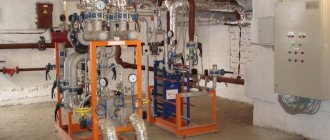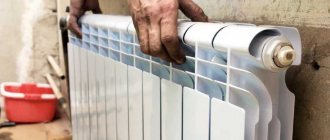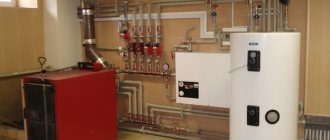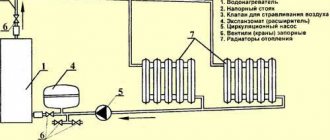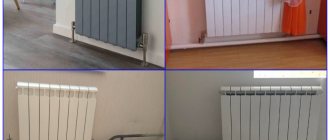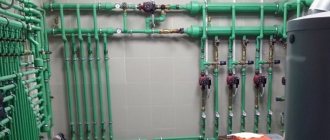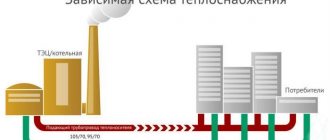Heating is something that every person thinks about before buying a house or apartment. The people who compile the ratings claim that this criterion is in second place, even surpassing cost. There are other data that indicate that water and heat consumption in Russian houses is several times higher than European indicators.
Central heating of apartments does not bring the desired result. And it's a matter of interruptions in heating and hot water. But the cost of utilities only increases. In addition, the entire pipeline system in Russia is very worn out, including boiler equipment. As a result, when calculating heat loss, the figure comes out to 50 percent, which is very high.
It’s easy to understand that everyone is starting to think about apartment heating. This is a way out of this situation. Because it will be profitable from a financial point of view and more efficient in terms of heat supply. This method of autonomous heat supply for apartment buildings is the best today.
What is it about?
Before equipping your apartment with such an additional heat source, it is worth understanding how it works. Apartment heating is the creation of a mini-boiler room in each individual sector. After this, residents can individually set their desired temperature and change it as needed. For such an arrangement you will need:
- Boiler. Depending on the area of the apartment, you need to make a reserve of 20 percent so that the unit does not work at its limit. Today there are a variety of models on sale with the desired set of functions.
- Devices for recording fuel consumption. This includes meters and other heating elements.
- Air capture equipment. This is required during the combustion process.
- Pipes for removing smoke and gases.
Wiring diagrams for modern horizontal heating systems
Modern multi-apartment residential buildings and private cottages of any number of floors are increasingly equipped with horizontal heating systems. A necessary element of such a scheme is one or more (in an apartment building - in each entrance) vertical two-pipe risers, which have branches/entrances into separate rooms/apartments on each floor. Further laying of pipelines is carried out in a “horizontal” way.
When installing such systems, builders invariably face the difficulty of laying heating pipes to radiators. The pipelines of the vertical systems, laid along the walls from top to bottom, did not particularly disturb the residents. Horizontal pipes laid openly along the walls become a factor that interferes with the normal operation of the premises and do not fit well into their interiors. Therefore, various methods of horizontal hidden laying are used.
Branched dead-end wiring diagram with pipes in a screed
Pipeline layout in a branched dead-end circuit.
The minimum lengths of pipes and hydraulic resistance of the circuit are leveled by mutual crossing of pipelines, leading to an increase in the thickness of the screed (each centimeter costs from 40 rubles/m2).
Perimeter wiring of the heating system
Dead-end scheme with pipelines in the screed or under the baseboard.
Pipeline layout diagram for a two-pipe dead-end system.
The lack of crossing of pipes in the diagram is offset by the need to make holes in the walls (in the given diagram you need to drill five holes).
Layout of pipelines according to the scheme with associated movement of water (Tichelman scheme).
Pipeline layout according to the Tichelman scheme.
Here, the first radiator of the heating circuit has the shortest “supply” length and the longest “return” length, the last radiator is the opposite. The hydraulic resistance experienced by the coolant when flowing around the devices of the circuit is constant, which makes it possible to balance any number of radiators in a branch.
Collector-beam wiring of the heating system
Pipeline layout for a collector-beam system.
The prevalence of this scheme is constantly growing. The pipes here are laid in the floor screed in pairs (“supply” plus “return”), approaching each radiator from the collectors (respectively, “supply” and “return”). The advantage of the scheme is ease of installation (no crossing of pipes and wall holes). The disadvantage is increased costs due to the high consumption of pipes and additional costs for collectors.
An additional advantage of the beam scheme is the use of small diameter pipes. An apartment (floor of a private house) will require the use of pipes d=25 and d=32 mm for the perimeter wiring diagram. Accordingly, the thickness of the screed and the diameter of the tees that connect the radiators will increase. The cost of such an element is comparable to the price of the pipe.
The use of radial routing, which increases the length of the pipes, provides the final benefit by reducing their diameter.
Peculiarities
Apartment heating is gaining momentum in Russia, so today we can say exactly what the advantages and disadvantages are. Generally speaking, there are more pros than cons. To understand this issue, in 2000, the Russian State Construction Committee conducted some research in which autonomous heating was used in the construction of apartment buildings.
Today there are such houses in Smolensk and St. Petersburg. Wall-mounted boilers began to be actively used in other cities, because it was profitable. Even with a commercial building, this was taken as a basis. Because people understood that in this way it was easier to create the desired microclimate in the house and not overpay. After all, everyone has their own settings for recording heat consumption.
As a result, such experiments brought a lot of positive results, and living in apartments became more comfortable. After this, documentation appeared on the basis of which it was possible to build such houses. Nowadays, autonomous heating is at the peak of popularity. In addition, the regions appeared their own regulatory documents, according to which the apartment heating system was completely legalized.
As a result, the number of houses with such heat supply increases every year. This happens in different regions and cities. From this it is clear that efficiency is present at every stage. It is in this way that problems of the housing and communal system can be solved. At the same time, today they are even reconstructing old buildings.
Letter of the law no amateur performances
It is strictly prohibited to carry out such a complex reconstruction as the installation of an individual heating system without approval or even with minimal “deviations” from the project. Such amateur activity entails a fine. And, one way or another, you will have to return the living space to its previous condition within the prescribed period. If you do not want to incur double losses and get into trouble with the law, carry out all work exclusively in accordance with the available documentation.
Calculation of individual heating for an apartment should be carried out only by qualified specialists. The selection of equipment is carried out on the basis of the climatic characteristics of the region, heat loss of premises, room area, etc. - you are unlikely to be able to objectively take into account all the factors yourself
What does the user get?
General positive aspects:
- The consumer himself keeps track of and controls the heating level of water and premises. There are no interruptions, warm water all year round, heating can be turned on at any time.
- An apartment heating system allows you to save gas, but at the same time maintain the desired heat level. In addition, it becomes possible to reduce the numbers in payment receipts. And today these indicators are of great importance for every person.
- It is easier to build an apartment building with individual apartment heating, because there is no need to cut into the central pipe, obtain permission and build a new main. If there is a stable gas supply, construction can take place in any, even the most remote, territories. The payback on such a structure occurs quickly. All developers are guided by this, as they manage to save a decent amount.
- Apartment gas heating is an environmentally friendly solution that many people choose. Boilers with a closed combustion chamber are installed in apartments, so there is no need to install additional ventilation. This installation operates independently, since everything necessary is available inside. Combustion products immediately go outside and dissipate, while modern installations are designed to meet all acceptable criteria and safety for the environment.
Types of radiator connections
The main methods of connecting heating system devices are several types:
- Lateral (standard) connection;
- Diagonal connection;
- Bottom (saddle) connection.
Side connection
Lateral radiator connection.
Connection from the end of the device - supply and return are located on one side of the radiator. This is the most common and effective connection method; it allows you to remove the maximum amount of heat and use the entire heat transfer of the radiator. As a rule, the supply is at the top and the return is at the bottom. When using a special headset, it is possible to connect from bottom to bottom, this allows you to hide the pipelines as much as possible, but reduces the heat transfer of the radiator by 20 - 30%.
Diagonal connection
Diagonal radiator connection.
Connection diagonally to the radiator - the supply is on one side of the device from the top, the return is on the other side from the bottom. This type of connection is used in cases where the length of a sectional radiator exceeds 12 sections, and a panel radiator is 1200 mm. When installing long radiators with side connections, there is uneven heating of the radiator surface in the part furthest from the pipelines. To ensure that the radiator heats up evenly, a diagonal connection is used.
Bottom connection
Bottom connection from the ends of the radiator
Connection from the bottom of the device - supply and return are located at the bottom of the radiator. This connection is used for the most hidden installation of pipelines. When installing a sectional heating device and connecting it using the bottom method, the supply pipe approaches on one side of the radiator, and the return pipe on the other side of the bottom pipe. However, the heat transfer efficiency of radiators with this scheme is reduced by 15-20%.
Bottom radiator connection.
In the case when the bottom connection is used for a steel panel radiator, then all the pipes on the radiator are located at the bottom end. The design of the radiator itself is made in such a way that the supply flows through the manifold first to the upper part, and then the return flow is collected in the lower radiator manifold, thereby not reducing the heat transfer of the radiator.
Bottom connection in a single-pipe heating circuit.
The constant increase in tariffs for housing and communal services causes a natural desire among residents of apartment buildings to install independent individual heating systems. Modern construction provides for zoned floor-to-floor and then apartment-by-apartment heat supply at the design stage.
The original solution for wiring the heating in the floor of the apartment hides the system of distribution pipelines, preserving the aesthetic appearance of the rooms. The independence of installation schemes for process pipes at individual facilities makes it possible to create an individual project for a heat supply scheme and install various heating devices.
Benefits for the developer
It was the companies that build houses that received benefits, which began to bring them less expenses:
- There is no need to lay expensive heating mains and create heating points.
- The installation of metering devices is not carried out.
- Houses are being built in any area of the city where there is an uninterrupted gas supply.
Companies that provide maintenance also have their advantages in such construction:
- It is easy to maintain gas boilers. This is a big plus for the relevant organizations.
- There is no need to disrupt the operation of the heating system in each apartment when replacing pipes during renovation or redevelopment of the premises. Everyone takes an individual approach and maintenance of their devices.
- Payment is made according to individual meters, which is easier to control. Debt is dealt with only with one user, and not with all residents of an apartment building. It is very comfortable.
In addition, executive authorities also benefit. They have their positive sides. These include:
- There is no need to build a central heating supply line, which means that the funds remain in the budget.
- There is no need to apply for subsidies.
- In heating networks there is no need to look for heat losses and reimburse costs.
- All responsibility falls on the apartment owners regarding fees and maintenance.
Hot water supply in heating systems
DHW in multi-storey buildings is usually centralized, with water heated in boiler rooms. Hot water supply is connected from heating circuits, both single-pipe and double-pipe. The temperature in the hot water tap in the morning can be warm or cold, depending on the number of main pipes. If there is a single-pipe heating supply to an apartment building with a height of 5 floors, then when you open a hot tap, cold water will flow out of it first within half a minute.
The reason lies in the fact that at night, rarely do any residents turn on the hot water tap, and the coolant in the pipes cools down. As a result, there is an overconsumption of unnecessary cooled water, since it is drained directly into the sewer.
Unlike a single-pipe system, in a two-pipe version, hot water circulates continuously, so the above-described problem with hot water does not arise there. True, in some houses, a riser with pipes is looped through the hot water supply system - heated towel rails, which are hot even in the summer heat.
In the summer, the entire system that provides central heating in an apartment building is tested. Utility services carry out routine and major repairs on the heating main, while disconnecting certain sections of it. On the eve of the upcoming heating season, the repaired heating main is re-tested (for more details: “Rules for preparing a residential building for the heating season”).
Features of heat supply in an apartment building, details in the video:
Presence of negative sides
There are many advantages, but there is always a negative side. First of all, apartment heating boilers require the removal of combustion products - smoke. Every square meter of the owner should not emit smoke into the street. This is strictly prohibited. Therefore, it will be necessary to create a single chimney. If you calculate the costs of it, it will turn out to be expensive. In addition, it will have to be built according to all the rules, and this will take a lot of time.
Such a house with apartment heating would be considered dangerous. Because in the area of each apartment there will be a boiler running on gas, and this substance is considered explosive. But when every person approaches the installation issue with all seriousness and chooses a high-quality boiler, this minus is missed.
What should you prepare for?
If we talk about private cottages, then such a heating distribution can be used there, but the owners need to prepare for some difficulties. An example of such a problem is that most batteries on the modern market are designed for connection to horizontal systems; they have the appropriate arrangement of pipes, technological holes and sections. Thus, the circuit, ideally, needs special radiators designed specifically for vertical installation.
Another problem arises from this feature. As you know, it is better to install radiators closer to the floor, this will allow for effective air exchange without unnecessary effort. Cold air, according to the laws of physics, will fall down, and heated air will rise up. A vertical radiator is extremely difficult to install in this way, which is why the heating is insufficient.
Requirements
It is necessary that the unit has all the appropriate fasteners:
- Flame presence control.
- Monitoring traction and temperature indicators.
- If there is no fire, the shut-off valve should operate.
Therefore, it is better to buy boilers from those manufacturers who have been on the market for more than one year. Also, annual maintenance must be carried out by the relevant authorities, and this cannot be waived. Today, gas distribution stations not only carry out the gas supply procedure, but also offer high-quality boilers at affordable prices. In this case, they are already fully responsible for the entire process of operation of the device.
Apartment without heating equipment: solution to the heating problem
Well, what options are possible when buying an apartment without a pre-installed boiler? Are there heating schemes that are at least close to gas in terms of convenience and efficiency?
Actually, the choice is small. Most heat sources are not applicable in a city apartment.
- Solid fuel boilers are becoming obsolete not even because of the need for frequent maintenance, but because there is no place to store firewood and coal in the apartment.
- A solarium means a VERY loud burner noise and a container with a volume of at least a couple of cubes. And then, imagine the process of filling it in an apartment building...
- Heating with electricity (more precisely, direct heating with its help) is very expensive. All energy-saving technologies (warm floors, infrared emitters, and even more so a variety of electric radiators and others like them) can, at best, reduce costs by a couple of tens of percent. Costs will still be 6-8 times higher than gas heating costs.
What remains? Actually, only heat pumps. Moreover, there are only two types - air-to-air and air-to-water.
Air heat pumps have been sold for a long time and cost quite reasonable money.
Costs in the budget version are easy to estimate: for example, for a two-room apartment with an area of 60 square meters, two household heat pumps C [email protected] Nordic CH-S09FTXN costing 22,000 rubles each are sufficient. This particular model was chosen not only for its low price, but also for its excellent energy efficiency combined with a wide range of operating temperatures for heating (up to -25C).
Let's try to estimate the costs of autonomous heating in an apartment building in this case. It’s more than easy to do the calculation yourself:
- According to SNiP, heating 10 m2 requires one kilowatt of thermal power.
Please note: new houses are being built with the active use of energy-saving technologies, so in practice this value can be safely divided by two. However, we will proceed from the worst-case scenario.
- For an apartment of 60 m2, 6 kilowatts will therefore be required. The rated power of one CH-S09FTXN is 3600 watts; however, inverter control technology allows flexible power adjustment without stopping and then starting the compressor.
- The COP parameter, meaning the ratio of effective thermal power to electrical power, for our air conditioners is 4.2. In order to provide a rated power of 6 kW, they will have to continuously spend 6/4.2 = 1.43 kilowatts.
Let's dwell on this value: on the one hand, as practice shows, with correctly calculated thermal power, the AVERAGE power consumption during the heating season does not exceed half the nominal value, on the other hand, the efficiency of heat pumps depends on the street temperature.
It is clear that at +15 and at -25 per kilowatt-hour of heat taken from atmospheric air, electricity consumption will be different.
- At the current cost of a kilowatt-hour, a day of heating will cost 1.43 kW * 4 r / kW / h * 24 hours = 137 rubles. The month is at 4110.
Is it a lot or a little?
On the one hand, the costs seem to be comparable to the costs of central heating. On the other hand:
- In reality, in a house with an insulated facade, the costs will be MUCH lower.
- The heating season begins when it is convenient for you.
- It is worth considering the immediate prospects. It is not difficult to predict an exponential rise in fossil fuel prices in the coming years. But electricity prices will grow much slower: the energy industry of all countries is switching to renewable sources.
The expected dynamics of price increases favor the use of electricity.
Which heating scheme is best to choose is, of course, up to you to decide.
Traction
In addition, apartment heating distribution has another weak side - draft. Those who are on the lower floor receive a large flow of wind and draft, but on the upper floors it is the opposite. In addition, most often people install a 24 kW boiler in their homes, but it is too powerful. This means that the equipment itself only works at half capacity, since a two-room apartment requires a minimum of energy.
But if you use hot water frequently, you need exactly this kind of power. As a result, before purchasing, you will have to carefully calculate how much power is required. The thermoblock operates even at a reduced load, but as a result, condensation forms in the pipe if the outside temperatures are negative. It is necessary to carry out complete and high-quality thermal insulation. If this is not done, you will have to purchase additional equipment.
Although experts believe that when any equipment is added to a wall-mounted boiler, an increased level of costs arises, and this is a significant reduction in benefits. When residents install boilers in their apartments, they make adjustments to reduce power. But no one calculates the level of efficiency and gas output. This means that there may be serious body losses, which would also result in useless expenses.
Switchgears
The elevator unit with all its piping can be thought of as a pressure circulation pump, which supplies coolant to the heating system under a certain pressure.
If the facility has several floors and consumers, then the most correct solution is to distribute the total coolant flow to each consumer.
To solve such problems, a comb is designed for the heating system, which has another name - a collector. This device can be represented as a container. The coolant flows into the container from the elevator outlet, which then flows out through several outlets, with the same pressure.
Consequently, the distribution comb of the heating system allows the shutdown, adjustment, and repair of individual consumers of the facility without stopping the operation of the heating circuit. The presence of a collector eliminates the mutual influence of the heating system branches. In this case, the pressure in the heating radiators corresponds to the pressure at the elevator outlet.
Freezing
Another point is that only the apartments are heated. This means that the entrance, attic, and basement are not heated. During the cold season, freezing will occur. As a result, the service life of the building, namely its suitability for habitation, is reduced. In addition, residents in the center of the house are in an advantageous position because the heat from neighboring apartments is available to them. When the house is new, not all apartments are sold out, the walls are cold, which means there is a load on the apartment with an autonomous heat supply. And this is a plus to the indicators on the counter.
Select the number of pipes
The scheme may involve the presence of one or two pipes:
- The option with one pipe implies that the coolant circulates in a closed loop, and the radiators are connected in series. This design feature leads to the fact that the temperature of the last battery will be lower than that of the first devices. However, with a short contour, this shortcoming is naturally corrected. As an additional way of adjustment, you can use the taps between the radiator pipes. Minimum volumes of materials for forming the system, no need for a circulation pump, small volume of circulating coolant - these properties can be attributed to the advantages of the technology.
- The two-pipe scheme is based on the installation of two circuits. The first is used to supply coolant to the radiators, while the second sends cooled water to the boiler for new heating. When laying, you must remember that the pipes must run next to each other, because the radiators are connected in parallel. An additional pipe increases the total volume of coolant used; often it is impossible to supply it by gravity, and therefore it is necessary to install a circulation pump. However, despite some installation inconveniences, the system is more reliable than the first option, since the formation of an air lock is eliminated.
Summing up
Many people living in apartments with apartment heating are worried because not everyone treats boilers responsibly. This is a complex system that requires periodic monitoring and testing. From a legal point of view, everyone decides for themselves. Moreover, all checks must be carried out by experienced, educated specialists. This service is paid, but it will pay for itself. Because malfunctions can lead to additional figures on the accounting system.
When choosing an apartment, everyone decides for themselves what is best for them. But before you start, you should weigh all the positive and negative sides. Of course, there are many advantages, since each person decides for himself when to heat his apartment and when to turn off the heating. Removing the disadvantages is not so difficult - all this can be solved in the modern world.
You can make the transition to apartment heating yourself. Namely, lay pipes and install a boiler. As for gas, only experienced people with proper documents do this. It will not be possible to give an exact price, since everyone chooses the boiler themselves, and their prices vary. Such equipment looks neat and will not spoil the existing interior design.
Aesthetics and comfort
The aesthetic side of the issue also plays an important role. Increasingly, consumers are placing increased demands on the interior of their home. Designer renovations have come into fashion, implying that the interior matches a certain style.
At the same time, not every style is able to accommodate “scoop” risers in every room, and leaking pipes can turn expensive repairs into a pitiful sight quickly enough.
The horizontal arrangement of the distribution pipes allows you to hide them in the floor screed, which significantly increases the visual appeal of the room and the possibilities of interior decoration.
In addition, modern people no longer want to put up with conditions and adapt to the climate. When investing in real estate, the buyer wants to get housing that is comfortable in all respects.
In winter, the temperature regime is especially changeable: after severe frosts, sharp warming may occur, and the temperature increases several times. Naturally, if the radiators heat up as before, the apartment will become hot.
You will have to open the windows and create drafts, and the question arises: why pay for heat when it is unnecessary? Horizontal systems allow you to regulate the temperature of each individual apartment, and radial systems allow you to regulate the temperature of each individual room.
Advice! Using heat meters allows you to take into account only the heat you need and avoid paying for an overheated room.
Minuses
- Expenses. Installing and purchasing a heating system will cost a tidy sum. The boiler, pipes, batteries, the work of gas service specialists and hired craftsmen, documentation and design - all this costs separate money, which together will significantly empty your pocket.
- The apartment will be damaged. When installing the system, the integrity of the interior partitions, interior decoration and flooring will be damaged. There will be a lot of debris and dust left, just like after renovation. For cleaning, you may even have to hire a cleaning company, since the consequences will be observed for a long time, settling on the floors and furniture from the walls and ceilings.
- Service. You will need to constantly hire service center technicians to service the boiler at least once a year. A specialist inspects the equipment for possible damage and integrity. This will eliminate the possibility of negative consequences for apartment owners and their neighbors.
- Documentation. It will take a lot of time to obtain all permits for installing autonomous heating in an apartment.
- Explosion hazard. Gas equipment must be carefully monitored during operation; as a result of an explosion, not only the owner’s apartment, but also several neighboring ones or an entire entrance may be damaged.
- Harm. When gas burns, it releases harmful carbon and carbon monoxide compounds. To ensure that these products are removed from the premises, a high-quality ventilation system must be installed.
- Possible lack of heating. If gas or electricity is turned off in the house, there will be no heat or hot water.
- Dimensions. The boiler and its adjacent components will take up significant space in the apartment; to hide pipes and other components, additional design tricks will be required.
District heating structure
If you pay attention to the heating scheme of an apartment in multi-storey buildings, it is the same almost everywhere:
- At the thermal station, the coolant (for multi-storey buildings - water) is heated in special boilers to a temperature of +130 -150 degrees.
- To avoid the formation of steam, it is further supplied through heating mains under high pressure to residential buildings (you can find out more about the operating pressure in the heating system of an apartment building on our website).
- Valves are installed at the entrance of the heating main pipe to the house, allowing you to control the level of water supply to its heating circuit.
By the way, if you have radiators in your apartment or you decide to install them, then we advise you to familiarize yourself with the important questions that you may have: how to choose the right radiators, replacement and adjustment, service life and repairs, flushing heating systems, diagrams and methods connections, types of radiators and their installation, noise in the radiators, as well as what should be the temperature of the heating radiators in the apartment.
Further distribution of the coolant depends on how the heating of the apartment building (residential) is supplied, that is, what is the design diagram of the heating system:
- Single-pipe apartment heating (2017), for all its attractiveness in the form of low price and reliability, is not the most popular type of heating system.
This is due to the fact that the coolant passes through all the risers and radiators of the building through one pipe, and only then returns through the return line for heating and subsequent circulation. If water is supplied from above, then the hottest radiators will be on the last floors, while on the first they are slightly warm, and, vice versa, when supplied from below. Fortunately, this type of connection is rare today. Read about what the temperature of heating radiators in an apartment should be on our website. - The two-pipe system has clear advantages over its one-pipe counterpart.
The coolant does not have to go through such a long and winding path, since when it gets hot into the radiator, it almost immediately passes into the return pipe, from where it runs back to the heating station. The only drawback of the system is the larger number of pipes, which means more costs, but they are paid off by the uniform distribution of heat throughout all rooms of the building. Find out more about the layout of heating pipes in an apartment, as well as how to properly hide the pipes.
IMPORTANT! It is on a two-pipe system that heat meters can be installed and the heating temperature of radiators can be controlled. If necessary, it can be reduced, creating significant savings. By the way, a circulation pump will also help save money.
Read about how to choose the right one and how it works here.
By the way, a circulation pump will also help save money. Read about how to choose it correctly and how it works here.
As the practice of recent decades has shown, centralized heating in an apartment has ceased to be a “sentence”, since it has become possible (not for everyone!) to switch to individual heating of housing (read more on our website on how to refuse central heating in an apartment building). In addition, it can be used to heat the bathroom. Autonomous heating in an apartment seems to be an ideal option; read more about it in the next section.
Installation
To create a heating system on the roof, you need to build a separate room. The roof boiler room is autonomous: once it is started, it is enough to carry out rare scheduled checks.
The process depends on the device variant. There are 2 types - built-in and block-modular.
Built-in
Boiler rooms built into the roof are used in new buildings. Such a device is installed only in a building under construction or in a building that has space to accommodate a thermal station. For built-in boiler rooms, the additional load on the walls of a multi-story building must be calculated and a fire extinguishing module must be created.
Block-modular
To place a roof boiler room in a constructed building, a block-modular type is used. The most common installation option is during a major overhaul. A roof boiler room is installed in case of restoration of the heating system. The project is created based on the characteristics of the building. The device is then created and delivered to the required building.
Before installation, the roof is inspected:
- Check the condition of the load-bearing supports.
- Apply a protective coating to the installation point. It is a concrete pad.
- Sound-absorbing material is installed.
Having completed the preparation, the boiler room is connected to the heating network. It is set up and the coolant is distributed. Having connected to the heating, they begin operation.
What to pay attention to
Before installing the device, it is necessary to take into account that it creates a load on the structure. Because of this, the following rules must be observed:
- It is prohibited to place the boiler room on the ceiling above residential premises.
- It is prohibited to place equipment in premises adjacent to residential premises.
- When designing, the size of the house in which it is planned to be located is observed.
- When designing, an emergency shutdown system is created.
Can a house with central heating switch to apartment heating?
A house with central heating can switch to apartment heating. Reasons for this:
- unwillingness to wait for the start of the heating season;
- tariff growth;
- dishonesty in the work of heating services. Due to the late switching on of heating and insufficient heat, an unfavorable microclimate is established in the house. Its consequences can be dampness, mold, condensation.
- To switch from central heating to apartment heating, you need to prepare:
- technical passport of the apartment;
- document for the apartment;
- application for reconstruction and project for reconstruction of the apartment;
- consent of each apartment tenant.
Find out from your heat supplier or management organization whether it is possible to disconnect one apartment from central heating or whether only a mass transition for the entire house is permissible.
After approval and coordination, gas supply drawings (the most popular fuel for apartment heating) are prepared, consumption and other technical conditions are calculated. If you are interested in electric heating, contact Energosbyt. In this option, a fire inspection certificate is required (the walls of the apartment must be made of non-combustible material, which is usually the case in cities). Contact the Sanitary and Epidemiological Supervision Authority for permission if you use a coaxial air duct with an outlet to the facade of the building.
Contact an installation company with a valid license for complete installation of the system. Documents at this stage: certificates for the equipment that is planned to be installed; instructions for their installation; a copy of the installation company's license; service contract.
Gas heating must be connected and started by a gas service specialist.
Place the boiler for servicing.
Inform the gas service that you have switched to apartment heating.
A gas boiler
It’s worth saying right away: gas REALLY
is the cheapest source of heat for heating. At least for now. Let's weigh the pros and cons of this scenario.
Advantages
Practice shows that the difference in payment between centralized heating and autonomous heating using gas ranges from 2 to 3 times at the same temperature conditions.
Why is central heating so expensive?
It’s clear that the first, almost unconditional reflex is to blame greedy officials for everything. However, tariffs for heat in housing and communal services have, in addition to someone’s ill will, quite sound justifications.
- They pay for gas, which is used to produce heat by boiler houses and thermal power plants, at a higher rate than private individuals.
- No one has canceled the depreciation of equipment. Boilers require periodic repair and maintenance; In addition, the tariffs are forced to include planned replacement of equipment.
- Annual repairs and planned replacement of heating mains also put a burden on your pocket.
- Your home heating system needs to be serviced. This expense item includes the planned replacement and repair of risers, elimination of radiator leaks, inspection and replacement of valves in the elevator assembly, checking and boring of nozzles, monitoring the temperature conditions of the elevator and a hundred other different works that we often do not notice.
- Finally, all heat losses: on a heating main with stripped thermal insulation, in an open entrance, even in the thermal power plant itself are paid for... that’s right, you too.
Another important advantage that an apartment heating system has is independence. I think everyone has had to freeze at home while waiting for the heating to start and suffer from stuffiness on a hot April day. implies that you provide the temperature you need at any given time, in accordance ONLY
at your own comfort.
Flaws
Of course, it could not have happened without them.
The use of exhaust combustion products through a coaxial air duct to the facade of the house means that it is better not to open the windows again. The soot that is inevitable during gas combustion will fall inside the premises.
The photo shows just such a new building. Channels for air intake are installed on the façade.
- Gas consumption in the corner and middle apartments of the house will vary. In the case of central heating, this, albeit somewhat comical, problem of social inequality is solved by the same amount of payment for heat.
- The greater the total amount of gas equipment in the building, the greater the likelihood of a gas leak with the corresponding consequences. Yes, modern boilers are much safer than Soviet-style gas stoves; however, in general the gas is still explosive.
